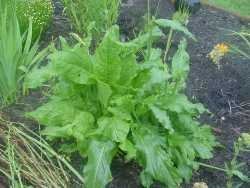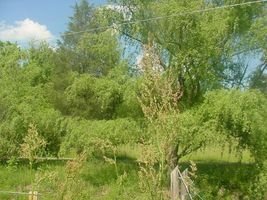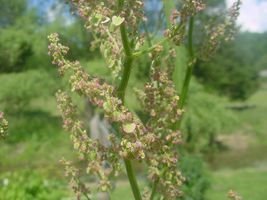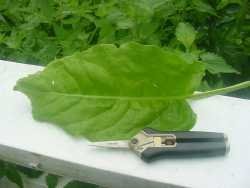





Sorrel has been around for thousands of years, found both in edible dishes and herbal preparations, but generally under-used as a food in the United States. There are many kinds of sorrel; two are known as French sorrel although one is really common sorrel and they are distinctly different.
Common sorrel (Rumex acetosa) is sometimes known as French Sorrel, but the true French sorrel is Rumex scutatus, often called Buckler sorrel. True French sorrel has smaller, arrow-shaped leaves (somewhat like the sheep sorrel found in weedy yards) that grow close to the ground less than a foot tall and is milder tasting than common sorrel. It is used to make the delightful classic French sorrel soup. Both are easy to grow, and both are culinary. (Sheep sorrel is also edible.) Common sorrel is what I have in my garden. It has a tart, lemony flavor and can be used with mild salad greens to add bite. The leaves are large, broad and almost fleshy (like some lettuce); it thrives on being ignored and is pest-free so far in my garden. I do take care to cut the flower stalks before they mature, lest it become invasive. Sorrel is a perennial, and holds up well to winters here in the southern Appalachian mountains.
Common sorrel is what I have in my garden. It has a tart, lemony flavor and can be used with mild salad greens to add bite. The leaves are large, broad and almost fleshy (like some lettuce); it thrives on being ignored and is pest-free so far in my garden. I do take care to cut the flower stalks before they mature, lest it become invasive. Sorrel is a perennial, and holds up well to winters here in the southern Appalachian mountains.
Sorrel is definitely a spring vegetable; mine is already gone to seed in early June, along with most of my lettuce and spinach. Sorrel should be harvested young for the most tender leaves and best taste.

 Sorrel flowering
Sorrel floweringPeople prone to kidney stones should avoid sorrel as it is high in oxalic acid. (It is a close relative of rhubarb but with far less oxalic acid.) The acid in the leaves will react with cast iron, giving off a metallic taste; sorrel cooked in aluminum cookware can draw out enough aluminum ions to be toxic. Stainless steel pots and utensils are advised. Sorrel tea should also be avoided for the oxalic acid, and because it can have diuretic properties.
 The leaves of sorrel are rich in potassium, vitamin A and vitamin C. At one time sorrel was used to fight scurvy because of the high vitamin C content. Cooked sorrel is often puréed as a base for fish sauces and poached egg dishes. I have seen sorrel added to a basic cream of potato soup with good results, or used in place of half the spinach in a dish. Raw, sorrel is generally used in salads.
The leaves of sorrel are rich in potassium, vitamin A and vitamin C. At one time sorrel was used to fight scurvy because of the high vitamin C content. Cooked sorrel is often puréed as a base for fish sauces and poached egg dishes. I have seen sorrel added to a basic cream of potato soup with good results, or used in place of half the spinach in a dish. Raw, sorrel is generally used in salads.
Sorrel is a nice balancing side dish for rich fatty meats and oily fish. It does not dry very well but can be puréed and frozen for later use in soups and sauces. The Joy of Cooking cookbook has a nice recipe for cream of sorrel soup.
In addition to common sorrel (Rumex acetosus) and French sorrel (Rumex scutatus), there are many others including Sheep Sorrel (Rumex acetosella), Blood Sorrel (Rumex sanguineus), Indian Sorrel or Bladder Dock (Rumex vesicarius), and Patience Dock (Rumex patientia).
“Red-veined Sorrel [Rumex sanguineus] is a new variety bred particularly for salads with deep red veins contrasting with the bright green leaves to make an attractive plant. Common sorrel, often considered an herb, grew wild as a weed in Europe. The taste is sharp and tart.” Lois Tilton
I hope you will consider expanding your repertoire of greens in the garden and try some sorrel!
Sorrel Sauce (suggested for fish or fowl)
2 medium shallots, minced
1 tablespoon butter
About 20 finely chopped sorrel leaves, stem and tough veins removed
1/2 cup dry white wine
1 2/3 cup heavy cream
In a medium saucepan over moderately-low heat, melt the butter and sweat the shallots until soft, about 8 minutes. Add chopped sorrel leaves and "melt" (the leaves will quickly cook down and become extremely tender). Add white wine, bring to a simmer and cook until reduced by about a quarter. Add cream, bring to a simmer and cook until thick enough to coat the back of a spoon.
The sauce can be made ahead and reheated.
The Slow Cook
Some sorrel plant and seed suppliers:
Common Sorrel (Rumex acetosa)
PlantScout vendors
The Cook’s Garden
Goodwin Creek Gardens
The Gourmet Gardener
Richter’s Herb Specialists
French Sorrel (Rumex scutatus)
PlantScout vendors
Artistic Gardens
Pantry Garden Herbs
Sand Mountain Herbs
Richter’s Herb Specialists
Goodwin Creek Gardens
Photo Credits: All photos are copyright by the author.
Copyright © www.100flowers.win Botanic Garden All Rights Reserved